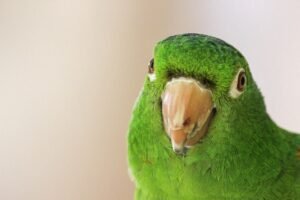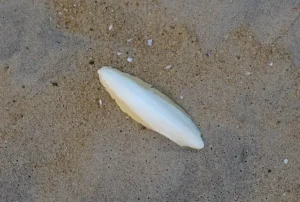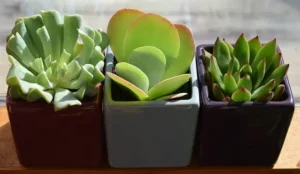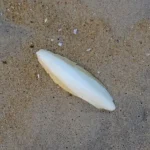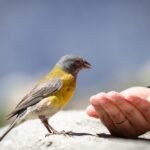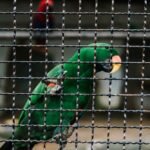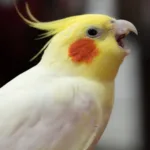A beak injury is a serious condition that can impact a parrot’s everyday life. It is equivalent to losing a tooth, except if you only had one.
Besides the obvious purpose of helping the parrot eat its food, the beak is involved in almost every single task like grasping, grooming, exploring, and communicating.
A parrot’s beak is made up of both living and nonliving tissues, and it continues to grow. This growth helps the beaks heal minor cracks by naturally growing out.
The beak can grow back from minor injuries when the damage is not in the jaw bone. However, when the injury is a bit more serious, the beak may not grow back the same as it was before.
In the case of a serious injury like a broken beak, the beak cannot repair itself. In such cases, the parrot will have to get a prosthetic beak.
Quick Navigation
What Should You Do If Your Parrot Breaks Its Beak?
Before you take your parrot to the vet, it is crucial to manage the bleeding that may be happening.
For minor bleeding, apply pressure on the area. However, if bleeding from the beak is heavy, it means the injury is more than just a surface crack and has penetrated deeper layers of the beak.
In such a case, applying pressure may not be enough. The best way to stop bleeding is to use blood clotting powder. If you don’t have it at home, apply ice on the parrot’s beak.
However, you should keep a clotting agent handy, in case your parrot breaks a blood feather or has any other injury.
While you’re trying to manage the situation at home, do not use superglue or any other adhesive for that matter. It can not only exacerbate the wound but also possibly get into the parrot’s eyes.
Keep the broken piece of the beak with you or if the broken part is hanging loose from the jaw bone, hold it in place. Sometimes the vet may be able to reattach it if the piece is solid.
The vet may apply a topical antibiotic on the wound and sedate the bird. However, the treatment can vary based on the severity of the injury.
If the beak is in a condition where it cannot grow back, the most likely solution would be to reattach the beak or fit a new one.
What Causes Beak Injuries?
The beak is formed around the jaw bones and consists of the upper and lower beak. The part of the beak closer to the bird’s head, contains more blood vessels and nerve endings, making it sensitive to pain and bleeding if injured.
Beak deformities in parrots can be present from birth or can occur due to traumatic injuries, infectious diseases caused by viruses or nutritional deficiencies, and imbalances.
Fight With Other Birds
Although parrots are quite peace-loving, not all birds are compatible with each other. Parrots can fight for over many things including their territory, toys, food, or owner.
These disputes within the cage need to be contained before it gets out of hand, especially when there is a size difference between the two birds. Many a time, the larger parrot can bully other birds in the cage and their attacks can be vicious.
If you put a new bird in a cage, make sure to introduce them properly and see how they get along. You may be able to get a sense of animosity between the two by observing their behaviors. It is usually not a good idea to leave a new bird alone unsupervised.
Accidents
As a bird flies around the house, there are a number of ways it can hurt itself. We cannot always look after our parrots when they’re out of the cage and therefore, it is common for them to occasionally chip their beaks.
When a parrot collides with walls, windows, or other hard surfaces, the impact can result in trauma to the structure of its beak. Now, a parrot’s beak is quite strong and is capable of taking a lot of beating but sometimes the impact to the beak can be too much for it to handle, resulting in cracks and even fractures.
In addition to that, a parrot can be more susceptible to injury from collisions when its beak has become overgrown. It becomes more vulnerable to cracks, fractures, or even pieces breaking off.
Parrots can mostly take care of trimming their own beaks but if you find that there is a usual growth on your parrot’s beak or if it does not appear to be in the right shape, you should take it to the vet for a beak examination.
Predatory Attacks
Parrots have a lot of enemies in the wild however their greatest threats in captivity can be other pets like cats and dogs. When a dog or a cat is not familiar with a bird, it may have hostile feelings towards it.
You should slowly introduce new pets to your bird and be cautious of them. Also, if a guest brings their pet home, try to keep it in a safe spot, away from the other pet’s reach.
Will A Broken Beak Grow Back?
Minor cracks can heal on their own over time by growing out. However, broken beaks do not put themselves together. Instead, it gradually grows out as the bird’s beak naturally grows.
However, the beak may not be able to regain its original shape and appearance. Sometimes, the bird may end up with a disfigured beak that could affect how it functions, potentially causing some difficulties for the bird in tasks like eating.
If a bird has a major beak fracture or deformation, it can affect its ability to perform the essential activities for survival.
This can lead to overall health issues, nutritional problems, and even lead to death. Although a parrot’s beak continues to grow throughout its life, a broken beak cannot grow back when a significant amount of tissue is lost.
Can A Parrot Survive With A Broken Beak?
The chances of survival for a parrot with a broken beak depend on the extent of the injury. While minor chips and cracks can usually heal over time, more severe injuries such as fractures or dislocations can be life-threatening.
An injury of such nature can cause the parrot to go in shock which can negatively impact its prognosis. It may also lead to a significant amount of bleeding so it’s crucial to take them to an avian vet immediately.
When a parrot experiences a partial or complete tear of the beak from its structure, it presents significant challenges. The beak is essential for a parrot’s ability to eat, as it helps them grasp and manipulate food. Without a functional beak, the bird may struggle to feed itself, which is crucial for its survival.
In some cases, parrots with broken beaks can be fitted with prosthetic beaks to help restore their ability to eat. However, this can be more challenging with smaller bird species.
Alternatively, over time, the bird may develop a layer of skin over the broken area of the beak, adapting to its condition, although, they will still be reliant on others to feed them.
Parrots with a beak amputation often have to rely on their caregivers for feeding, as they are unable to eat on their own. They may require a modified diet that consists of softer foods or those that are easier to consume. Hard foods like nuts may be difficult or impossible for them to eat.
A recent study published In The Pharma Journal examined the prognosis of a young Green Cheek Conure with a severe upper beak injury.
The incident occurred when the 8-month-old Green Cheek Conure was introduced to an older bird, a 1.5-year-old Green Cheek Conure. Initially, there were no noticeable changes in behavior from either bird.
However, after two days, the older bird began exhibiting aggressive behavior towards the younger bird, leading to a fight. More often than not, when a larger bird attacks a smaller bird, the outcomes can be fatal.
In this case, the older conure amputated the younger bird’s upper beak. The injury was managed but the bird was unable to eat or drink. As a result, it had to be put on a hand-feeding formula until it was fitted with an artificial beak.
How To Care For A Parrot With Beak Injury?
After a parrot has recovered from a beak injury, it may not be able to use its beak like before right away. The parrot may still feel pain when performing challenging tasks and sometimes would also refuse to eat.
Parrots with injured beaks need special care. They should be given soft foods that can be easily scooped up. You can offer them vegetables and fruits cut into tiny bits. You could also serve them mashed food as it would be easier to digest.
How To Prevent Beak Injury In Parrots?
Create A Safe Environment for Flying Indoors
Parrots are eager to come out of their cages, but when they do, they can be a troublemaker. And sometimes their playtime can land them into trouble. Flying into walls and windows is a common occurrence with most parrots.
It is wise to first introduce your parrot to its environment so it knows how to move around safely without getting injured. You should also remove any object that may potentially cause harm to the parrot when it is flying. Ceiling fans, mirrors, and windows are some of the common hazards in the house.
Balanced And Nutritious Diet
A parrot’s beak continues to grow and replace the older layer of keratin, ensuring it is strong and beautiful at all times. So a healthy diet can be extremely beneficial to the parrot’s beak health. You can also give them a cuttlebone to chew on to supplement their diet.
If a parrot is deficient in certain nutrients, particularly vitamin D and calcium, it can inhibit keratin production in their bodies leading to soft and rubbery beaks. These softer beaks are more prone to injuries and tears. So a parrot that is malnourished can be at a higher risk of beak injuries from accidents than if it were on a proper diet.
Clipping Wing Feathers
Not everyone is in favor of clipping their parrot’s wings, but you can shorten them in a manner that prevents excessive lift during flight. You should get it done by someone who is trained as it can potentially increase the chances of injuries if done incorrectly. This will keep your parrot from flying at high speeds and avoiding impact in case it crashlands.
